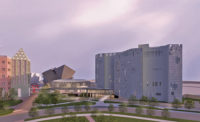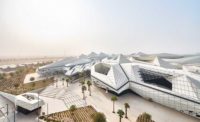The four-acre site sits along the tidal basin, opposite the Jefferson Memorial. Andrew Craig, project manager with Turner, says the site included, passing through it, unforeseen electrical and sewer lines, which had to be relocated.
As with much of the Mall, the site was originally created using fill taken from the nearby Potomac River. “If you go back 100 years, [this site] is actually in the Potomac River,” Jackson says. “It’s a landfill. We knew that we would have challenges trying to put a granite sculpture on a landfill.”
The three main elements used to create the Mountain of Despair and the Stone of Hope weigh approximately 1,600 metric tons combined. Tom McElwain, project engineer with Thornton Tomasetti, New York City, says numerous foundation options were explored, but ultimately the most cost-effective proved to be mat foundations supported by 343 structural piles. The piles were driven between 45 feet and 55 feet deep. To save time, Craig says the first 100 piles were ordered at 60 ft lengths. They didn’t have time to try to save money by fine-tuning the lengths on the first group, he adds.
Foundations under the granite sculptures are 2.5 feet thick, while the plaza foundations are one foot thick. A 2-ft-thick foundation was built to support a 220-ton crane used on-site.
The sculpture was created in China by Lei Yixin using Chinese granite and shipped to the site in 159 pieces. The largest piece, which depicts Dr. King’s arms, weighs 38 tons. The sculptor’s team was responsible for placement of the pieces, with support from the design-build team. Erection took 30 days, Jackson says.
Trees are planted on berms that rise from one to 12 ft high. Consultants expressed some concerns about the load on the site’s soft soils, and McElwain says structural piles were considered for support. Instead, the team was able to pursue a more cost-effective option by preloading for six months the berm sections with soils. Those soils were then excavated and replaced with the amended soils for planting.
Despite the drawn-out design and permitting process early in the project, Grant says the design-build team brought an element of teamwork to the project that was in keeping with the spirit of Dr. King.
“This was a very collaborative effort,” he says. “It goes back to the spirit of Dr. King. He didn’t march alone. He marched arm-in-arm with others.”








Post a comment to this article
Report Abusive Comment